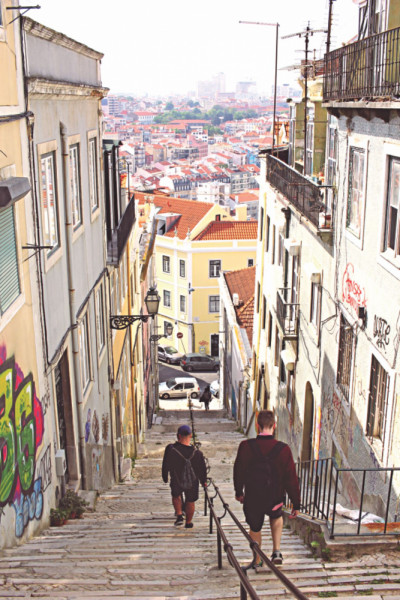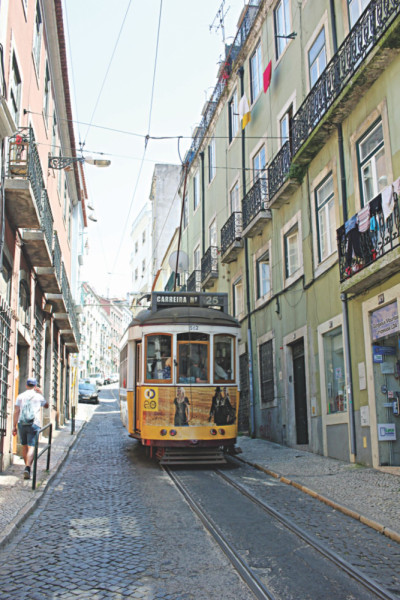Lisbon – the City of Egg Tarts

"What made you decide on Lisbon?" our Uber driver asks, as he winds his way through the rolling, narrow cobblestone streets of Bairro Alto.
"Egg tarts," is the reply. This is not untrue; most of my travels are at least in some part prompted by gastronomic ends. After an overlong, bitter winter spent in Germany, though, I had another motivation: heat. Desperate at the sight of yet more snow on the first day of spring, I looked south for respite.
Respite is exactly what I get within minutes of being here. Perhaps it is the warmth, or that my surroundings are suddenly peopled with a few more Indian sub-continentals, or that the dilapidated Lisbon streets offer a sharp relief from the cold, oppressive order of Germany, but I feel instantly at home. Yes, everywhere you look, there are signs of neglect and disrepair, signalling the economic stagnation Portugal has been grappling with of late. And while I'm not one to romanticise hard times, I'd be lying if I say I don't find this worn-out quality wonderfully becoming on Lisbon. I could chalk it down to a personal tendency towards the wabi-sabi aesthetics of beauty in imperfection and transience; yet it's hard to imagine these pastel-hued, wrought-iron-terraced old buildings, these impossibly slender, undulating alleys, failing to win over anybody.
Hours after landing, we're at Fabrica de Nata, the spot chosen to begin our egg tart odyssey. Trays of pasteis de nata, the golden, custard-filled puff-pastries, are transported across the confectionary via a rail-line of sorts on the ceiling. Everything on offer is delicious: the salted codfish fritter, the spinach croquette, and the tart itself. The server mentions that locals like to sprinkle on some powdered sugar and cinnamon; we throw on generous heaps, and the tarts are immediately transformed – and devoured.

The next day, we arrive at Pasteis de Belem to find a queue snaking out of the store and onto the end of the street; but this landmark patisserie is an essential Lisbon experience, and we aren't leaving. Happily, we're seated inside only a short wait later, surrounded by literally hundreds of eaters and an impressive display of azulejos: the decorative blue-and-white painted tiles typical of the region. There were plenty of baked goods to choose from, but the most famous is, of course, the egg tart. Originally concocted in the 18th century by the monks of the nearby Jeronimos Monastery, the coveted recipe was eventually sold to the founders of Pasteis de Belem when the monastery closed down. Should you decide on a glass of milk with your pasteis, you'll win an affectionate pat on the head from your elderly waiter. The tarts are a revelation - delicate layers of phyllo dough crisped to perfection with generous portions of butter, the centre warm and silky. This is, in short, what I came for.
Bellies filled, we walk to the aforementioned monastery, the stunning 15th century structure built in the Manueline style, and then onto the Tower of Belem, the limestone marvel sitting in the waters of the Tagus River. Walking, we find, is the best way to explore the labyrinthine interiors of Lisbon. It's not easy, mind you. The many steep ups and downs, and pavements of stone polished to slipperiness over time, make a good pair of walking-shoes mandatory. The rickety tram no. 28 is a tourist favourite, but it's perennially jam-packed and (as we were repeatedly forewarned) full of pickpockets.

Climbing up to any of the Miradouros (view-points) scattered throughout the city is strenuous, but you'll feel like you've earned the panoramic views that greet you at the top. At Castelo de Sao Jorge's Miradouro, a flock of free-roaming, screeching peacocks enhance the experience; at the Miradouro of Portas do Sol, drinks from the terrace's cafe provide the right complement to a spectacular sunset falling over the Alfama district.
Our next bakery, Confeitaria Nacional, is one of the oldest in Europe and, like Pasteis de Belem, still run by the descendants of the founders. The tart here is predictably good, as is its savoury sibling, the quiche.
The end of our trip is fast approaching – but not before we've ticked off the last tart-stop: Manteigaria. The long line-up outside the place hints at the riches waiting to be plundered inside. We've hardly finished our first batch of tarts when my friend pipes up, "should we get another round?" We join the queue once more! There's a pause after we've scarfed down the second batch. "Another round?" I ask. The answer is a resounding "Yes!" We stand in the line once more, and this time, I made sure to get a box-full to take with me back home.
Photo: Tonima Hossain






Comments